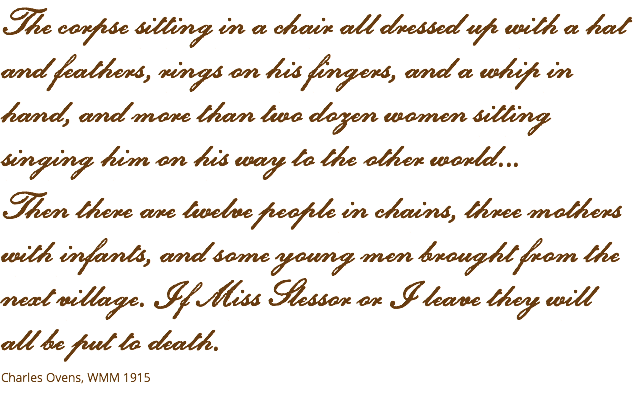Missionaries to Calabar faced a strong culture of superstitions
and beliefs that were held and enforced in local tribes and communities. Life was governed by fear of curses and punishments.
Witch doctors had a very strong influence over the local people and were held in great fear. They were called on by the tribal chiefs to apportion blame when accidents happened or disputes were to be settled. They would administer brutal justice which often resulted in the death of innocent people.
The esere bean, which is indigenous to the area and poisonous to humans were used at tribal trials to prove innocence. The accused were made to consume a potion made from the bean and it was considered that they were innocent if they vomited up the poison. If they died it was considered that they were guilty of whatever they had been accused of.
Other punishments included boiling oil being poured over the accused and taking the Mbiam oath involved having to drink a foul liquid described by Mary Kingsley, explorer, as made of ‘filth and blood’ and recite an oath.
Mary intervened when Chief Edem of Ekenge’s son Etim died as the result of a house building accident. The witch doctor was summoned to say who was responsible for this death and another village was accused. To try and avert many deaths, Mary had an elaborate coffin made for the dead son and dressed him up in a European suit with feathers and other decorations to make him look as impressive as possible for onlookers to stop the murder of prisoners taken from the other village. Chief Edem was wary of carrying out his threat to kill in Mary’s presence and so she and Charles Ovens, the missionary carpenter, kept a vigil for two weeks to save the prisoners.

Dundee City Council, Dundee Art Galleries & Museums: A Calabar chief
Mary gradually won the trust of local people as she lived with them, learning about their lives and helping them. She was gradually asked to mediate in disputes and resolve issues. Working tirelessly she tried to improve the lives of women and children in particular, sometimes putting her own life at risk in dealing with highly charged confrontations with chiefs, other local leaders and witch doctors.
Spirit houses were traditionally built for the use of dead men’s spirits
Scottish Charity No. SC032781
© Mary Slessor Foundation 2016